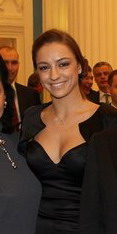Rhythmic gymnastics
Rhythmic Gymnastics is a sport that combines elements of gymnastics, dance, and apparatus manipulation. It is recognized and governed by the Fédération Internationale de Gymnastique (FIG), which establishes the rules and regulations for international competition. Rhythmic gymnastics is characterized by its emphasis on artistry and flexibility, in addition to physical strength and agility. Competitors perform routines to music using one of five apparatus: ribbon, hoop, ball, clubs, and rope, with the latter being less commonly used in recent competitive programs.
History[edit | edit source]
Rhythmic gymnastics developed from a host of related disciplines, including classical ballet, German and Swedish system of free exercise, and folk dance. It was recognized as a sport by the FIG in 1963, and the first World Championships were held in 1963 in Budapest, Hungary. The sport made its Olympic debut at the 1984 Summer Olympics in Los Angeles, initially only for female athletes. Over the years, rhythmic gymnastics has evolved significantly, with changes in the code of points, apparatus, and competition structure.
Apparatus[edit | edit source]
Each apparatus in rhythmic gymnastics requires a unique set of skills and offers different challenges:
- Ribbon – involves swings, circles, flicks, and throws. The ribbon must remain in motion and not get tangled.
- Hoop – includes rotations, rolls, throws, and passes through and over the hoop. Gymnasts must demonstrate control and versatility with the hoop.
- Ball – emphasizes smooth, flowing movements and throws. The ball should be in constant motion, demonstrating the gymnast's control.
- Clubs – involves asymmetric movements, mills, throws, and catches. The clubs are used to demonstrate coordination and rhythmic dexterity.
- Rope – (less commonly used) includes jumps, skips, and swings. The rope's length should be in proportion to the height of the gymnast.
Competition[edit | edit source]
Rhythmic gymnastics competitions are divided into individual and group events. In individual routines, gymnasts perform four different routines, each with a different apparatus. Group competitions involve routines where five gymnasts work together, using either the same apparatus or a combination of two different apparatuses.
The scoring system for rhythmic gymnastics is based on the FIG Code of Points, which evaluates the difficulty of the elements, the execution of the routine, and the artistry of the performance.
Training[edit | edit source]
Training for rhythmic gymnastics focuses on developing flexibility, strength, endurance, coordination, and artistic expression. Gymnasts typically begin training at a young age and spend several hours a day perfecting their technique and routines.
Notable Competitors[edit | edit source]
Over the years, rhythmic gymnastics has seen many notable competitors who have left a significant mark on the sport. These athletes are celebrated for their technical skills, artistry, and contributions to the evolution of rhythmic gymnastics.
Conclusion[edit | edit source]
Rhythmic gymnastics is a sport that combines the physical demands of gymnastics with the artistic elements of dance, creating a unique and captivating discipline. It continues to evolve, with new elements and routines being developed, pushing the boundaries of what is possible in the sport.
Search WikiMD
Ad.Tired of being Overweight? Try W8MD's physician weight loss program.
Semaglutide (Ozempic / Wegovy and Tirzepatide (Mounjaro / Zepbound) available.
Advertise on WikiMD
|
WikiMD's Wellness Encyclopedia |
| Let Food Be Thy Medicine Medicine Thy Food - Hippocrates |
Translate this page: - East Asian
中文,
日本,
한국어,
South Asian
हिन्दी,
தமிழ்,
తెలుగు,
Urdu,
ಕನ್ನಡ,
Southeast Asian
Indonesian,
Vietnamese,
Thai,
မြန်မာဘာသာ,
বাংলা
European
español,
Deutsch,
français,
Greek,
português do Brasil,
polski,
română,
русский,
Nederlands,
norsk,
svenska,
suomi,
Italian
Middle Eastern & African
عربى,
Turkish,
Persian,
Hebrew,
Afrikaans,
isiZulu,
Kiswahili,
Other
Bulgarian,
Hungarian,
Czech,
Swedish,
മലയാളം,
मराठी,
ਪੰਜਾਬੀ,
ગુજરાતી,
Portuguese,
Ukrainian
Medical Disclaimer: WikiMD is not a substitute for professional medical advice. The information on WikiMD is provided as an information resource only, may be incorrect, outdated or misleading, and is not to be used or relied on for any diagnostic or treatment purposes. Please consult your health care provider before making any healthcare decisions or for guidance about a specific medical condition. WikiMD expressly disclaims responsibility, and shall have no liability, for any damages, loss, injury, or liability whatsoever suffered as a result of your reliance on the information contained in this site. By visiting this site you agree to the foregoing terms and conditions, which may from time to time be changed or supplemented by WikiMD. If you do not agree to the foregoing terms and conditions, you should not enter or use this site. See full disclaimer.
Credits:Most images are courtesy of Wikimedia commons, and templates, categories Wikipedia, licensed under CC BY SA or similar.
Contributors: Prab R. Tumpati, MD






